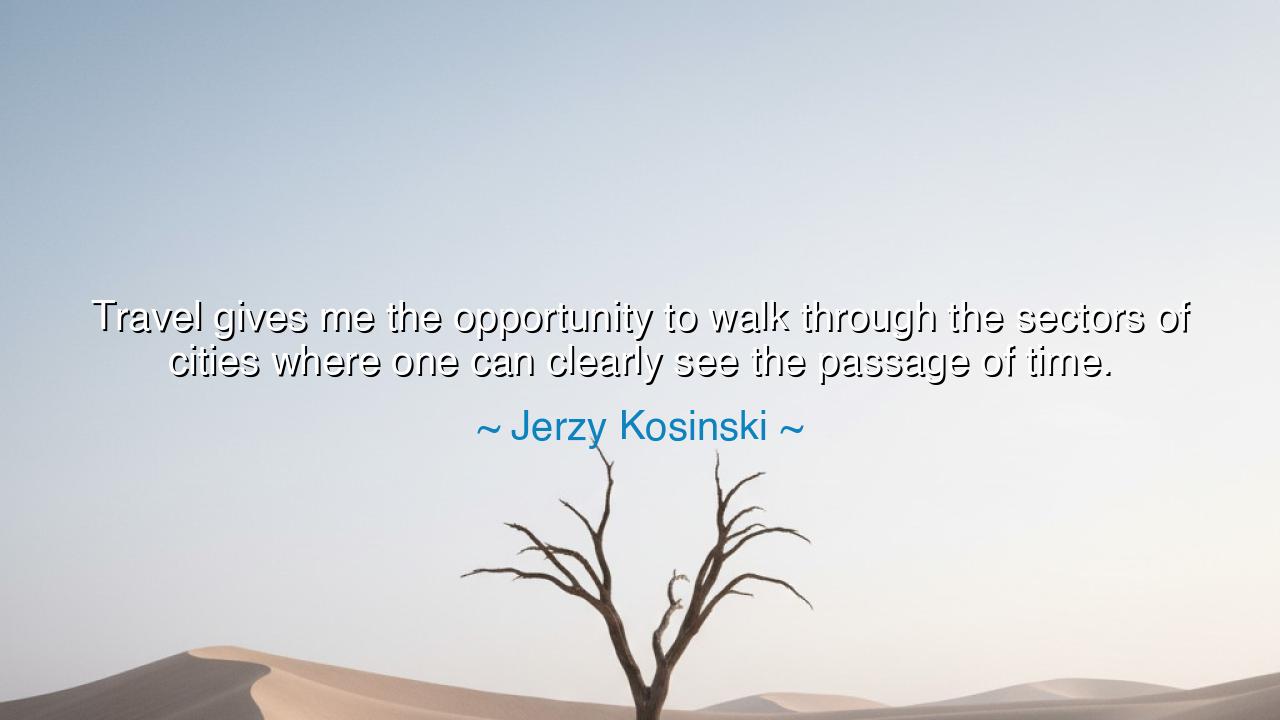
Travel gives me the opportunity to walk through the sectors of
Travel gives me the opportunity to walk through the sectors of cities where one can clearly see the passage of time.






Jerzy Kosinski once said with the voice of a wanderer and a poet: “Travel gives me the opportunity to walk through the sectors of cities where one can clearly see the passage of time.” In this phrase, there is more than the observation of a traveler. There is the reverence of a pilgrim who knows that cities are not merely collections of stone and steel, but living testaments to time itself. To walk their streets is to walk through centuries, to feel the breath of the past upon one’s cheek, to see the rise and fall of empires inscribed in brick and marble.
The ancients themselves knew this sensation. When Roman legions marched into Greece, they saw not only the present cities but the crumbling temples of gods older than their own. They stood in awe before the Parthenon, knowing it had already seen generations pass away. The sight of broken columns and weathered statues spoke to them as powerfully as any oracle. For in the ruins of cities, one does not merely see decay—one sees the passage of time, the layering of human striving upon human striving, as tides upon a shore.
Kosinski reminds us that travel is not simply movement from place to place, but an encounter with history made visible. To walk through Paris is to move from medieval lanes to Renaissance squares, from the scars of revolutions to the glass towers of the present age. To walk through Istanbul is to feel Byzantium and Constantinople whisper in the shadow of mosques and markets. Every city is a palimpsest, a manuscript written and rewritten, its streets carrying the handwriting of each age. The traveler who sees this does not merely consume a place—he communes with its spirit.
Consider the story of Edward Gibbon, who, upon wandering among the ruins of the Roman Forum in the eighteenth century, conceived his monumental work The Decline and Fall of the Roman Empire. He saw in the broken arches not only loss but the weight of centuries pressing upon his soul. His great history was born because he walked where time had written its marks most clearly. Just so, Kosinski reveals that the true gift of travel is not to see novelty, but to perceive continuity—the unbroken thread of human endeavor across centuries.
The wisdom here is profound: we too are part of this passage. When we stand among old stones or walk ancient streets, we are reminded that our lives, though brief, are woven into the same tapestry. The laughter of a child playing in a Roman alley two thousand years ago, the cry of a merchant in a medieval bazaar, the stride of a modern traveler—all are notes in the same eternal music. Travel teaches humility, for it shows us that time will pass over us as it has passed over those before, leaving behind only the traces we carve into the world.
The teaching for us is this: do not rush blindly through cities, but walk with reverence. Look upon their old quarters, their crumbling facades, their contrasting towers, and see in them the passage of centuries. Let it remind you that every life, every moment, is part of something far greater than itself. Do not merely seek comfort or entertainment in your travels; seek to feel the weight of time, to recognize your place in history’s river.
Practically, this means traveling with eyes wide and heart awake. Visit the great monuments, yes, but also wander the narrow alleys where the stones are worn by countless feet. Speak to elders who remember the city as it once was. Notice the marks of change—the old next to the new, the ancient beside the modern. In doing so, you will honor not only the city, but the eternal passage of time itself, and you will return home not only with memories, but with wisdom.
Thus, Kosinski’s words shine as a teaching for the generations: travel is the art of walking through time. The wise traveler does not only move across space, but also across centuries, feeling the breath of those who came before and preparing a path for those yet to come. To see the passage of time in cities is to see it also in yourself—and in that vision, to live more humbly, more gratefully, and more fully.






AAdministratorAdministrator
Welcome, honored guests. Please leave a comment, we will respond soon